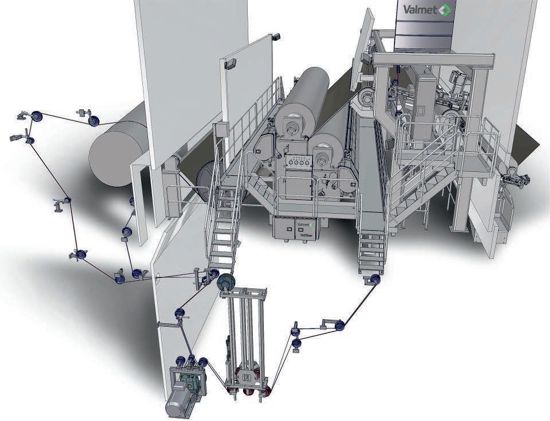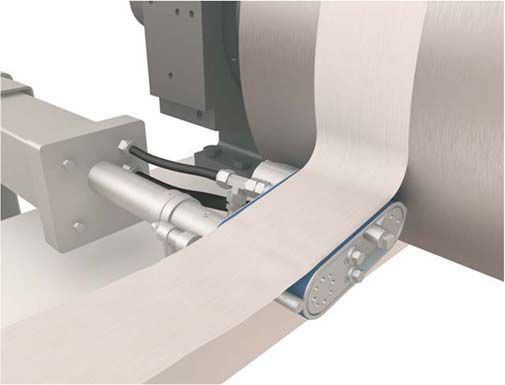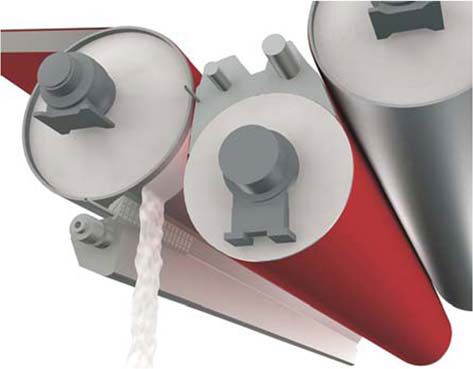Introduction to the tail threading process, efficiency and audits
Apr 7, 2020
The topic of tail threading is very important for all types of paper, board and tissue machines. After all, if you can’t tail the machine, production comes to a halt very quickly, tails build up in the machine, broke storage tanks fill up, ropes fall off, and operators are put in harms way. The cost of machine downtime can be over $15,000 per hour for large machines.
Tail threading process
Tail threading is required whenever the sheet is taken back up the machine by choice or by a sheet break. Once the sheet is broke back, operators clear the machine of all loose paper and perform any adjustments that are done during a sheet break such as changing trim squirts, changing doctor blades, and washing up the former and press section equipment. This process takes time.
When the machine is ready to tail, operators station themselves at key locations down the machine. They normally have air hoses in hand to assist the tail threading process as needed.
Tail threading occurs with a combination of equipment. The most basic components are ropes, sheaves, sheave off-track movement, rope stretchers and rope drives, as shown in the following figure.

An example rope run in the size press area
A ropeless tail threading approach will replace all rope equipment in one or more machine sections with advanced automated components for a faster, safer and more efficient process. These can be combined with or replaced by more advanced devices including water jet tail cutters, pickup plates, vacuum tail conveyors, air doctors, air blows, blow boxes and vacuum rolls. The level of automation is dependent on the grade, speed and the mill's need for high threading efficiency. Human and mechanical safety is enhanced by eliminating close calls and rope accidents.
Tail threading options vary based on where the equipment is located and what grade is being run. Here are a couple of examples, for a press section and dryer section.

Example of a tail threading conveyor used in a press section
The above press section tail threader uses a conveyor for pickup and tail threading from a center roll, a separate press or a double-felted press. Mechanical contact with the tail is facilitated by the conveyor's optimal vacuum level. The conveyor is very compact, so it's suitable for all press section geometries.

Example of tail threading through a single felted dryer group
The single felted tail threader manages tail threading by means of blow boxes and vacuum rolls, or special vacuum rolls with separate vacuum at the tail edge of the roll. Air blows on the doctor beams guide the tail onto the dryer fabric. The blow boxes and vacuum rolls create a vacuum under the dryer fabric. The vacuum effectively holds the tail on the dryer fabric, with the tail traveling around the bottom vacuum roll to the dryer cylinder above. If needed, tail threading can be interrupted and restarted using knock-off and cut-off blows at the desired point.
Tail threading efficiency
The goal of any tail threading attempt is for the tail to thread itself from one section to the next the first time with little or no operator assistance. Threading time per section should only take a couple of minutes depending on what type of draw adjustments and steam settings need to be made. Tail threading efficiency is a measure of the total time and number of attempts required to thread the machine.
A lot of things are happening during tail threading that affect threading efficiency. If just starting up from a long outage, the tail weight and moisture may not be optimum. Draws and dryer steam pressures may need to be adjusted to tail successfully. Too wet (weak sheet) or too dry (low stretch and sticks to dryer can) can cause tail threading problems.
Some mills use infrared handheld or permanent sensors to determine steam pressure setpoints. One mill targets 190 °F coming from the predryer sections as a good setting for after dryer tail threading. The higher the tail temperature is, the dryer it will be and the lower its stretch will be.
Another thing to keep in mind when tailing for a long time is can surface temperature in the tail area. The longer a tail runs in the same spot, the lower its temperature will be, causing the tail to get wetter over time.
There are many factors to adjust, set and monitor for efficient tail threading, including air blow and vacuum pressures, conveyor belt speeds and speed differences, tail width and position and tension of the tail. Paper strength, basis weight, moisture, web profile, length of threading distance and machine speed will all affect how the tail threading equipment operates.
Check the related links section of this article for the troubleshooting tail threading operation article for more tips and equipment descriptions.
Tail threading studies
Valmet's Tail Threading Survey audits the performance of the current tail threading process. The four stages of this survey consist of a kick-off meeting, an analysis during a machine shutdown, a report containing the detailed analysis, and an action plan based on Valmet expert's recommendations.
With a tail threading study, the main problem areas in the existing process can be identified and eliminated with the help of Valmet’s experts and their recommendations. Correct preventive maintenance actions bring savings in maintenance costs and ensure equipment availability and reliability.
A Valmet service agreement is designed to secure the optimal operation of the equipment, reduce threading times and improve maintenance efficiency. It is the right tool with which to better manage overall operations around the tail threading process in a systematic way.
For more immediate results, a Tail Threading Analysis and Adjustment is performed. All necessary and possible adjustments are made while the Valmet expert is on-machine. The analysis includes a written report and recorded video showing the analysis results and changes made in the process. Typical potential problems that can be found and rectified include:
- misalignment of components,
- plugged air jets,
- insufficient air flow,
- improper procedures and
- missing or damaged components.
Valmet has some of the most experienced tail threading experts in the paper industry. If you believe your tail threading process could be improved, contact your Valmet representative to assist you in reducing machine downtime due to tail threading.